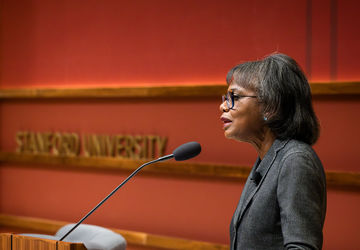Parallel visionaries tell the microhistories of Chinese Exclusion resistance

Kathryn Gin Lum
The late 19th century United States was a nation entangled in its own contradictions. Bounty and liberty were promised to white industrialist families who defined the era’s narrow vision of propriety and modernity. But those on the fringes of an increasingly white and Christian “land of opportunity” tell a different story. Two anti-Chinese Exclusion activists and public intellectuals, Wong Chin Foo and Yan Phou Lee, had intimate knowledge of the unevenly distributed American dream at the height of the Gilded Age.
Wong and Lee, both writers who published in English at a time when few written records of Chinese immigrants were preserved, personify two types of moral and religious leadership at the forefront of Chinese Exclusion resistance in the late 19th century. At the first Faculty Reseach Fellows talk of the 2023-2024 academic year, Kathryn Gin Lum described her work tracing the contexts that gave rise to their activism. Gin Lum is professor and department chair in religious studies, in collaboration with the Center for Comparative Studies in Race and Ethnicity at Stanford. She is also professor, by courtesy, of history in affiliation with American Studies and Asian American Studies. Her in-process book, tentatively titled The Excluded: Chinese Immigrants and the Soul of a Nation, provides a window into the formation of Chinese American identity under Chinese Exclusion through Wong’s and Lee’s parallel lives.
Wong Chin Foo was among the first known Chinese American activists. Orphaned through the Taiping Rebellion, he was raised by American Baptist missionaries. Wong immigrated to the United States in his early twenties, where his confrontation with American xenophobia inspired his work as a public intellectual. The forefront of his advocacy was the battle against the Chinese Exclusion Act of 1882, but the arc of his work spanned the fight against Chinese women’s coercion into the sex trade and the promotion of wider education about Chinese culture, particularly Confucianism. Wong endeavoured to make sense of and push against exclusion across domains of his activism, often in ways that were accessible to white people. He insisted upon the dignity of Chinese Americans—a term which he is believed to have originated.
Wong and Lee, both writers who published in English at a time when few written records of Chinese immigrants were preserved, personify two types of moral and religious leadership at the forefront of Chinese Exclusion resistance in the late 19th century.
Yan Phou Lee arrived to the United States in 1873 through the Chinese Educational Mission. A Yale graduate, Lee published the memoir When I Was a Boy in China, the first book in English written by an author of Asian descent. He sought to position himself as a bridge between American and Chinese cultures, which he accomplished by dispelling stereotypes about infanticide and non-nuclear family structures among the Chinese. Lee’s writing and activism was avowedly Christian, whereas Wong proclaimed himself a Confucian missionary.
“Wong and Lee hold up a mirror to the so-called family values of white Americans,” Gin Lum argued. This is clear in their complementary anti-exclusionist theses in The North American Review, where Lee retorted to Wong’s “Why Am I a Heathen” with his article, “Why I am Not a Heathen.” Both critiques of exclusionist logic purposefully complicated the idea of America as a bastion for pious white, Christian, heterosexual families. Wong wished to lay the contradictions of American life bare: “Love your neighbor as yourself is the great Divine law which Christians and heathens alike hold, but which the Christians ignore.”
Wong embraced the word “heathen,” a slur used to connote Chinese ancestral idolatry and immorality, in his denunciation of white American moral hypocrisy, arguing that it was the supposed Chinese heathen who most closely aligned with American moral values. In his rejoinder, Lee abandoned heathen as an exclusively Chinese term and instead embraced it as a signifier of collective moral failure. “I cordially invite all heathen—whether American, or English, or Chinese—to come to the Saviour,” he wrote.
Wong’s and Lee’s pursuits of a pluralistic American identity was not without their own forms of prejudice. “What both of them offer to white audiences is a vision of the United States as a nation that could and should open its gates to Chinese immigrants, Christian or not,” Gin Lum added, “but I also want to be attentive to the ways they conformed to societal norms and expectations to try to achieve acceptance.” When speaking about Chinese male immigrant laborers who lacked higher education and English fluency, Wong derided the group as sexually immoral and inferior. Anti-Black and anti-Indigenous sentiments were also present in his work. “In advocating for the rights of Chinese people to settle and become citizens, Wong also bought into a white supremacist, settler-colonist mentality,” Gin Lum concluded.
The Excluded: Chinese Immigrants and the Soul of a Nation depicts Wong and Lee up-close and in historical conversation with the long specter of anti-Asian hate in America. Gin Lum resists the simplification of these men, showing Wong and Lee to be both steadfast and contentious figures of 19th century American identity under Chinese Exclusion. Their story is one of pushing the United States to live up to its values, a pursuit that remains the nation’s most perennial struggle.


